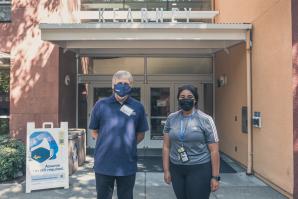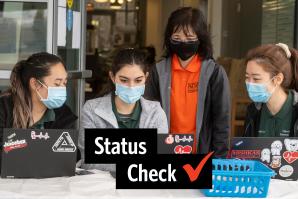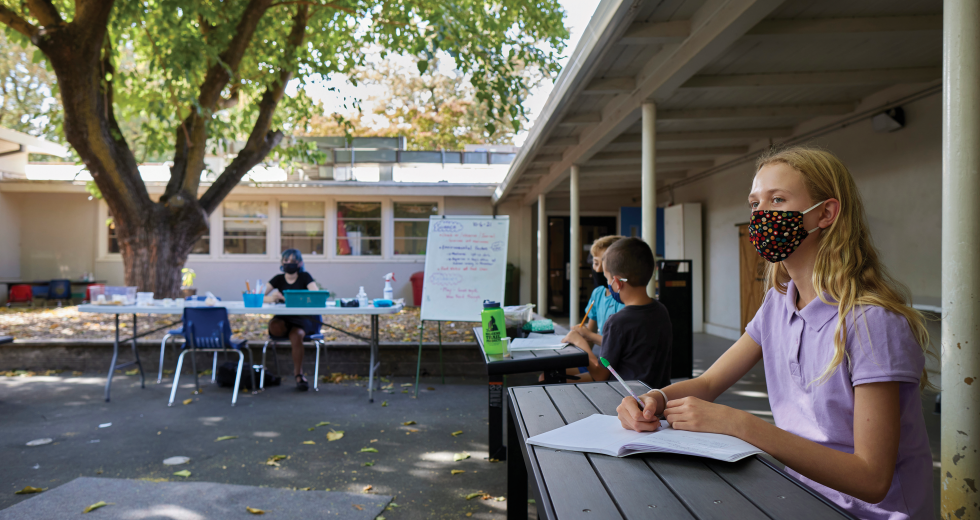Christina Setzer, an early childhood education teacher, has a unique perspective on the state of education nearly two years into the pandemic: She’s an employee of the Sacramento City Unified School District, a mother of two students in the district and one who recently graduated, and she is a graduate of SCUSD’s independent study program, Capital City School.
“My daughter’s not vaccinated yet and she’s 11, and I was really, really hesitant to send her back,” Setzer says of her youngest child. “But at the same time, she’s been at her school since kindergarten. … I was really disheartened that they weren’t going to have (a distance) option — her teacher was amazing last year.”
Most of California’s brick-and-mortar schools reopened for a partial year in spring 2021, and the majority of parents — some eagerly and some with trepidation — sent their children back to schools with pandemic modifications including staggered start times and mask requirements. Still, not every parent has chosen to return their children to full-time, on-site education for the current school year.
An April 2021 Public Policy Institute of California survey showed that roughly 75 percent of parents were in favor of full or partial reopening of public schools.
In an effort to reopen schools for children who thrived best with in-person instruction while addressing the needs of those parents who were not yet ready to send students back full time, the California Department of Education’s response has been to mandate that as public schools reopen, they must also offer either virtual independent study programs or a virtual learning curriculum. This bill, Assembly Bill 130, signed on July 9, 2021, is an extensive education omnibus trailer bill that requires (in part) online learning to provide some amount of synchronous instruction during the week, varying by grade level.
An April 2021 Public Policy Institute of California survey showed that roughly 75 percent of parents were in favor of full or partial reopening of public schools, meaning many parents still felt schools should remain closed or continue online only. For some, that decision has been influenced by the inability to vaccinate children under 12, while others realized their children have flourished in the online environment. Whatever parents’ feelings on reopening models, polling indicated eight in 10 felt their students had fallen behind academically in the remote learning system.
Educators have long understood that there is no such thing as a one-size-fits-all education model. And though it’s not been without growing pains, the past year and a half has brought together parents, teachers and legislators to expand educational options.
Many Charter Schools Already Prepared
Though AB 130 specifically exempts public charter schools from independent study requirements, many local charters already offer robust at-home learning options, either through independent study or virtual learning programs. Both models incorporate regular check-ins with a dedicated teacher with live, synchronous interaction daily for younger children.
Natomas Charter School, for example, is separated into five academies, two of which offer primarily off-campus options: Pursuing Academic Choices Together Academy, a homeschool-based program for students in kindergarten through eighth grade; and Virtual Learning Academy, where students in grades nine through 12 participate in a hybrid model where much of the work is done online, with some in-person workshops and the option to take community college courses in addition to required secondary courses. While those two programs’ structures adapt well to current requirements, additional planning provided a smoother path.
“Schools closed on March 12 — I’m pretty sure it was the day. About Feb. 25 we actually had an executive team meeting where we thought through what would we do if we got an order to close schools,” says Joe Wood, executive director of Natomas Charter School. “Of course, we naively thought it would be an order to close schools for two weeks, and it ended up being months.” That advance planning gave Wood and his team an opportunity to address potential issues that could have slowed down the transition to fully-distanced education.
“I do believe that the desire by parents and students to have a virtual offering will continue, especially if you continue — which we intend to — to make it a rich, engaging, excellent experience and that we continue to look at it for how to improve it.”
Cindy Petersen, Superintendent and CEO, Gateway Community Charters
Similarly, Gateway Community Charters in Sacramento County began offering a virtual academy for all grade levels at the beginning of the 2021-2022 school year, spurred by the realization that many parents were seeking additional flexibility. It too offers some on-site programs to complement its online components. GCC’s new virtual learning program is “very much targeted in relation to COVID and those that are COVID sensitive about returning to school,” says Superintendent and CEO Cindy Petersen.
Petersen estimates that roughly 60 percent of the virtual academy’s 125 students have transitioned from one of GCC’s other schools, indicating growing interest in continued online learning. “I do believe that the desire by parents and students to have a virtual offering will continue,” Petersen says, “especially if you continue — which we intend to — to make it a rich, engaging, excellent experience and that we continue to look at it for how to improve it.”
Scaling Difficulties
AB 130 required rapid adjustment even for the most well-prepared districts, but the transition has been considerably rockier for some.
Sacramento City Unified School District chose to fulfill the state’s requirement through its already-existing K-12 independent study option, Capital City School. However, enrollment in the program outstripped capacity, with only 400 of 1,600 enrolled students being assigned a teacher and receiving curriculum information by the school’s Sept. 2 start date, according to media reports.
According to the Sacramento City Teachers Association, Capital City School was already short-staffed, as were SCUSD’s in-person programs. District second grade teacher and SCTA President David Fisher says district administrators were unwilling to negotiate with the union’s request for a Department of Education waiver to create its own virtual learning academy, which SCTA believes would have alleviated the Cap City bottleneck.
“Our district waited until Aug. 19 to actually pose a plan to us,” Fisher says. “And so now they’re trying to staff virtual learning through independent study at more or less the last minute so this is why you’re finding so many parents and families frustrated, sort of left out in the cold.” Representatives of SCUSD did not respond to requests for comment.
While Setzer and one of her older children both had positive experiences as Capital City School graduates, she made a different choice for her younger children. “We opted out of doing Cap City, mostly because I already knew what Cap City was about. … Knowing the school, how small it was and how few teachers they had, I was like, I don’t know how they’re going to do this,” she says.
As for Setzer’s own students — children ages five and under — she’s been surprised by their resilience. “I was skeptical at first. … How do we even reach them in a meaningful way and engage with them through a screen?”
Setzer’s question is one most educators and parents have asked at one point or another in the past 18 months. As it happens, she says her young pupils responded well to the virtual format: “We were really surprised to see that they were really able to engage, and the parents were happy to have something, especially during those early days when everything was shut down. … And so really we were providing one of the only social experiences that many of them were tapped into.”
“My goal was to create the best virtual programs in the region, and I feel like we actually met that goal.”
Robert Kinder, Principal, Davis School for Independent Study
The Davis Unified School District’s Davis School for Independent Study began more than three decades ago, but its Virtual Academy opened at the beginning of this school year. While it had been in the works since Principal Robert Kinder joined DSIS just under five years ago, the program got off the ground just in time to meet the state’s timeline.
“We aim high, and we set the bar really high for our virtual programs,” Kinder says. “And it frankly equated to a really long and exhausting summer for me and my team, but coming together, we’re really proud. My goal was to create the best virtual programs in the region, and I feel like we actually met that goal.”
Moving Forward
Providing alternatives to exclusively on-site based education has proven to be a difficult task for school districts, especially in light of ever-evolving health news. However, few would question the necessity of expanding flexibility and alternative educational options during this uncertain period. Will the demand for virtual curriculum and virtual independent programs continue beyond the pandemic? School administrators think so, though whether its demand among districts grows or offers a transition back to the classroom will vary.
For Wood, he sees the growth in Natomas Charter School’s independent learning and virtual academy programs as providing a larger umbrella for students transitioning back to in-person instruction. “If you want the completely isolated program we’re probably not the school for you,” he says. “But if you’re looking for a reentry process back into the educational system, we’re actually a good bridge for those families.”
Davis’ Kinder concurs. He says independent study students “really appreciated what distance learning did for them and the flexibility that came along with it. “We absolutely anticipate to continue to have a virtual program in the future.”
Editor’s note: A student’s name was removed from a caption at the request of a parent.
–
Stay up to date on business in the Capital Region: Subscribe to the Comstock’s newsletter today.
Recommended For You

Capital Region Schools Coping With COVID-19
Here is a rundown of COVID-19 mitigation efforts at some public
school districts, colleges and universities in the Capital
Region.

Status Check: University of the Pacific Reopens After Major Changes
The University of the Pacific’s three campuses in Stockton, Sacramento and San Francisco have reopened — with COVID-19 vaccinations required.

California Students in Richer Areas Far More Likely to Be Back in Classrooms
A CalMatters data analysis reveals a wealth gap between students more likely to receive in-person instruction and those less likely to have that option.

Virtual Variations
With the coronavirus pandemic forcing most college classes online, recent high school graduates are finding their choices have changed
Students are weighing all the options, including attending community college, learning online or postponing college altogether.




